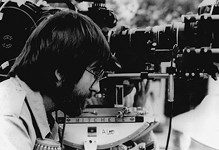Trial by Jury
1994 Directed by Heywood Gould. Starring Joanne Whalley-Kilmer, Armand Assante, Gabriel Byrne, William Hurt.
REVIEWED By Alison Macor, Fri., Sept. 16, 1994
In the first few minutes of Trial By Jury, I felt a familiar panic as I realized that Hollywood had churned out yet another slick and pretty waste of celluloid. However, watching the entire film changed my opinion, if only slightly. Trial By Jury is one of those films that has some intriguing performances trapped within a mediocre story. Whalley-Kilmer stars in this courtroom thriller as Valerie Alston, a single mother chosen to be a juror in a trial pitting the government against mob kingpin Rusty Pirone (Assante). Trial By Jury provides an interesting look at human nature as Valerie must decide between doing her civic duty and keeping herself and her son alive. Hurt turns in an understated, surprisingly humble performance as Tommy Vesey, an ex-cop irreversibly tainted by the scum he once fought against. As a character, Pirone is one dimensional, but this is something Assante, a veteran of the television miniseries, has turned into an art form. Whalley-Kilmer deserves the most credit for her complex portrayal of a woman facing the underside of her own character. As Valerie, she discovers not only her capacity for morally unflattering behavior, but also the power these actions have to influence others. Not incidentally, as the owner of an antique clothing shop in downtown Manhattan, Valerie's wardrobe and taste in antique furniture are impeccable. Clothes and furnishings from the 1940s add a stylish class to her character and the film's look. Unfortunately, this homage to earlier times works against the film in terms of some of its stilted dialogue straight out of a 1930s gangster film. Daniel Graham (Byrne) is the U.S. attorney prosecuting Pirone, and he too is not much more than a stock character delivering stale lines about truth and justice. In spite of this, Trial By Jury still manages to retain our interest in the plot. What saves this film is Whalley-Kilmer's multi-layered creation of her character and the film's investigation of the power of the survival instinct. Additionally, the story pulls no punches as it portrays the gray areas inherent in both sides of the law. Maybe there is no wrong or right, the film seems to say. The winner should be the person who is strongest in the face of adversity, using all of his or her resources to stay in the game.
A note to readers: Bold and uncensored, The Austin Chronicle has been Austin’s independent news source for over 40 years, expressing the community’s political and environmental concerns and supporting its active cultural scene. Now more than ever, we need your support to continue supplying Austin with independent, free press. If real news is important to you, please consider making a donation of $5, $10 or whatever you can afford, to help keep our journalism on stands.
Feb. 26, 2010
April 11, 1997
Trial by Jury, Heywood Gould, Joanne Whalley-Kilmer, Armand Assante, Gabriel Byrne, William Hurt







